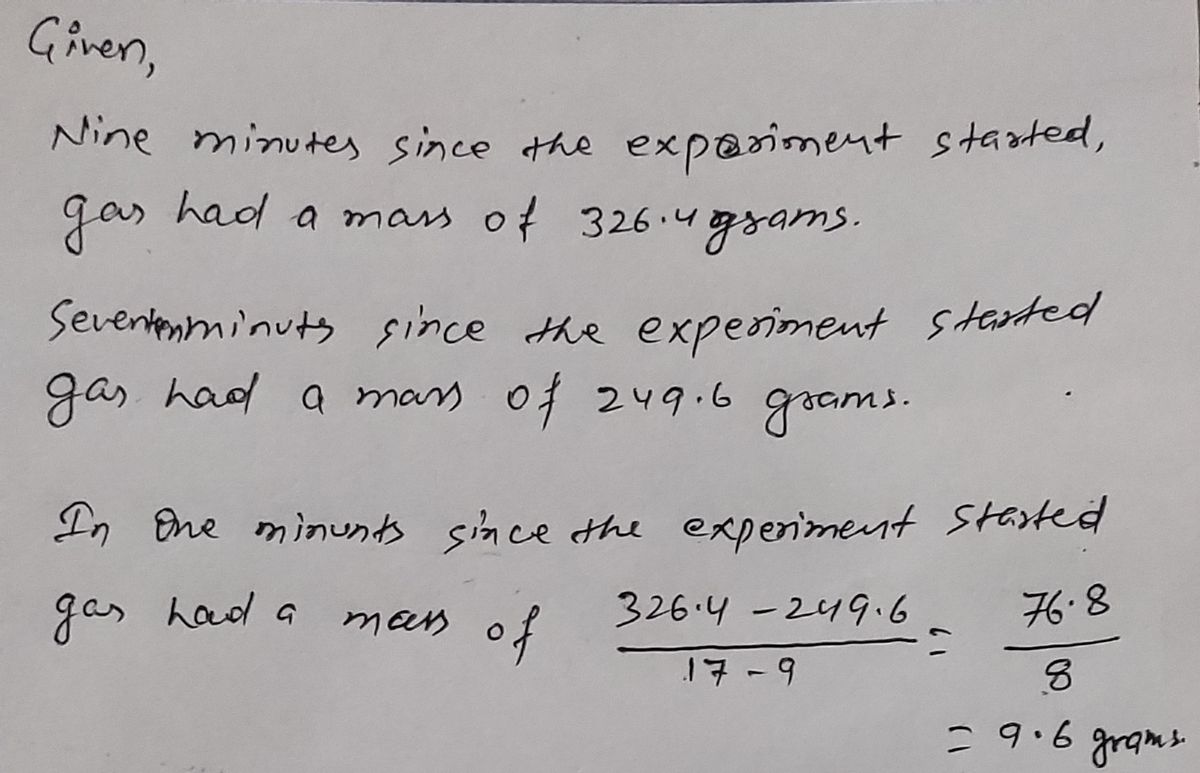Scientists are conducting an experiment with a gas in a sealed container. The mass of the gas is measured, and the scientists realize that the gas is leaking over time in a linear way. Nine minutes since the experiment started, the gas had a mass of 326.4 grams. Seventeen minutes since the experiment started, the gas had a mass of 249.6 grams. Let x be the number of minutes that have passed since the experiment started, and let y be the mass of the gas in grams at that moment. Use a linear equation to model the weight of the gas over time. a. This line's slope-intercept equation is b. 32 minutes after the experiment started, there would be grams of gas left. c. If a linear model continues to be accurate, minutes since the experiment started, all gas in the container will be gone.
Scientists are conducting an experiment with a gas in a sealed container. The mass of the gas is measured, and the scientists realize that the gas is leaking over time in a linear way. Nine minutes since the experiment started, the gas had a mass of 326.4 grams. Seventeen minutes since the experiment started, the gas had a mass of 249.6 grams. Let x be the number of minutes that have passed since the experiment started, and let y be the mass of the gas in grams at that moment. Use a linear equation to model the weight of the gas over time. a. This line's slope-intercept equation is b. 32 minutes after the experiment started, there would be grams of gas left. c. If a linear model continues to be accurate, minutes since the experiment started, all gas in the container will be gone.
Algebra & Trigonometry with Analytic Geometry
13th Edition
ISBN:9781133382119
Author:Swokowski
Publisher:Swokowski
Chapter5: Inverse, Exponential, And Logarithmic Functions
Section5.6: Exponential And Logarithmic Equations
Problem 52E
Related questions
Question
100%

Transcribed Image Text:Scientists are conducting an experiment with a gas in a sealed container. The mass of the gas is measured, and the scientists realize that the gas is leaking over
time in a linear way.
Nine minutes since the experiment started, the gas had a mass of 326.4 grams.
Seventeen minutes since the experiment started, the gas had a mass of 249.6 grams.
Let x be the number of minutes that have passed since the experiment started, and let y be the mass of the gas in grams at that moment. Use a linear equation
to model the weight of the gas over time.
a. This line's slope-intercept equation is
b. 32 minutes after the experiment started, there would be grams of gas left.
c. If a linear model continues to be accurate, minutes since the experiment started, all gas in the container will be gone.
Expert Solution
Step 1

Trending now
This is a popular solution!
Step by step
Solved in 3 steps with 3 images

Recommended textbooks for you

Algebra & Trigonometry with Analytic Geometry
Algebra
ISBN:
9781133382119
Author:
Swokowski
Publisher:
Cengage



Algebra & Trigonometry with Analytic Geometry
Algebra
ISBN:
9781133382119
Author:
Swokowski
Publisher:
Cengage



Algebra: Structure And Method, Book 1
Algebra
ISBN:
9780395977224
Author:
Richard G. Brown, Mary P. Dolciani, Robert H. Sorgenfrey, William L. Cole
Publisher:
McDougal Littell

Glencoe Algebra 1, Student Edition, 9780079039897…
Algebra
ISBN:
9780079039897
Author:
Carter
Publisher:
McGraw Hill